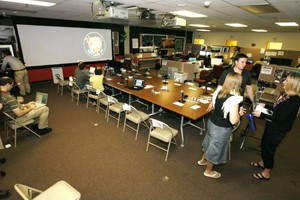The fun won’t be over when the UA-led Phoenix Mars Lander’s batteries fail and its computers freeze up in the Martian arctic after the end of its three-month mission.
With the permanent Science Operations Center now built in Tucson – and the recognition the UA enjoys as the first university to lead a mission to another planet – university officials are saying that ‘Phoenix’ is only just beginning to pay dividends to the school.
The long-term impact of the mission will be to draw more and more dollars, talent and fame to the UA community, as well as making it a permanent player in space exploration.
Peter Smith, who leads the ‘Phoenix’ team as its principal investigator, summed up the mission’s importance to the UA in one word: “”Prestige.””
“”The university is trying to become a world-class research facility,”” he said. “”Having a mission like this – returning some really impressive science about an unexplored region of Mars – that puts us on the map.””
While the UA works to build its reputation, the Science Operations Center where UA scientists control the mission is literally on the map – permanently. The SOC gives the university a platform to lead future missions, said Michael Drake, director of the Lunar and Planetary Laboratory.
‘Phoenix’ is not meant to be a one-shot deal, but the first of several proposed UA missions to outer space. With the experience and recognition that comes from leading a Mars mission and the facilities to lead future missions, the UA is eligible to win future contracts for space exploration. That’s a boon to the entire university community, he said.
“”Most people think, ‘Oh, you’ve spent $420 million and just dumped it on Mars.’ Well, that’s not the way it gets spent,”” Drake said. “”It gets spent here on Earth and $50 million or so was spent here in Arizona, most of it here in Tucson. That really translates into a huge economic boost for the city, the county and the state.””
Drake pointed out the fact that highly paid scientists and engineers brought in for the mission also buy groceries.
“”And then the grocery clerk gets paid, and he buys a movie ticket and the movie clerk gets paid and so on. The dollar multiplies,”” he said. “”A number like a factor of two is not an unreasonable one. We probably had a $150 million impact on Tucson just by winning this mission … I like to think about it like this. We create new knowledge, we create jobs.””
The mission also enhances the overall reputation of the university, bringing attention to other great things happening on campus, Drake said.
“”There’s an old expression: A rising tide raises all ships,”” he said.
The initial landing celebration brought in media representatives from across the world, drawing reporters from outlets such as Irish Television and the Finnish Broadcasting Company.
“”You know, Tucson’s kind of isolated if you haven’t noticed. We’re not a hub,”” Smith said. “”People who have never heard of the University of Arizona now see it in the news,”” Smith said.
Every visiting press member received a UA Visitor’s Guide and ample opportunities to tour UA facilities. The mission has also partnered the UA with universities in Denmark, Germany and Switzerland, as well as the Canadian Space Agency.
That kind of exposure is hard to come by, Drake said.
“”Bowl games – they usually have an ad about the two schools,”” he said. “”This kind of coverage just dwarfs that one-time-only coverage,”” he said.
The mission will likely bring better talent to the school in the form of faculty and students, Smith said.
“”People say, ‘Well, the university is doing great things. I want to go there too,'”” he said.
President Robert Shelton said that he gets asked about the mission “”all the time.””
“”It shows that the university knows how to attract people and support programs that are the very best,”” he said. “”While you can’t be number one at everything, it’s important that you know how to do it in select areas.””
And the UA hopes to be number one in space exploration for some time. UA scientists have already submitted a proposal to lead NASA’s Osiris mission. That project will seek to return samples of organic materials from an asteroid to help scientists understand how the building blocks for life may have been seeded on the early Earth.
The UA is also planning to compete for the Google Lunar X Prize, a $30 million international competition to land a robot on the moon, travel 500 meters across the surface and return at least one gigabyte of high-definition television information to Earth. Both missions would be controlled from the UA’s SOC, Drake said.
Continued missions like these would be a huge return on the state’s investment in the university, he said.
Each year the Lunar and Planetary Laboratory spends about $3 million in state money as opposed to $30 million from competitive, peer-reviewed contracts and grants, he added.
“”That’s stuff that we win because of the capabilities of the faculty,”” Drake said. “”That is a 10-to-1 return on the investment. I wish I could find a 10-to-1 return on my investment.””
‘Phoenix’ will keep reaping rewards for the UA, because it makes the school competitive in the space game for the long haul, he said.
“”We’ve shown that we can operate a spacecraft on the surface of Mars,”” Drake said. “”We will be, for probably a long time, the only university that has that capability in the world.””









